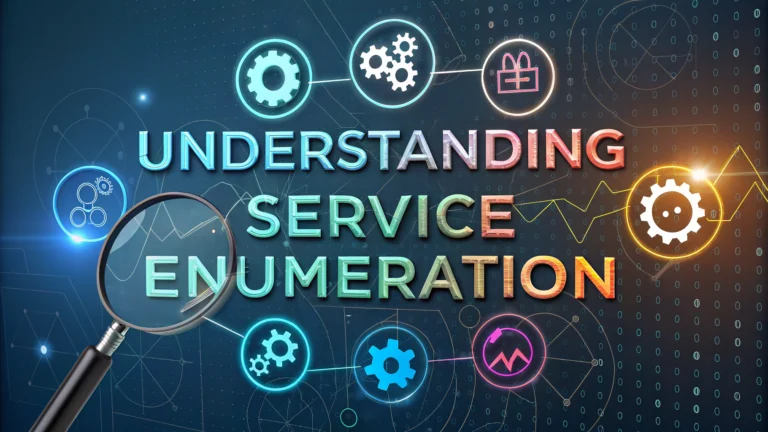Service enumeration helps security professionals map out active network services, ports, and potential vulnerabilities during penetration testing.
This phase reveals critical information about system configurations, running applications, and possible entry points that could be exploited by malicious actors.
Understanding service enumeration techniques enables testers to build comprehensive attack strategies and identify security gaps before they can be exploited.
Common Service Enumeration Tools
- Nmap – Network mapper for port scanning and service detection
- Netcat – Versatile networking utility for port scanning
- Wireshark – Network protocol analyzer for detailed traffic inspection
- Masscan – Fast port scanner for large networks
Key Service Enumeration Techniques
- Port scanning (TCP/UDP)
- Banner grabbing
- Version detection
- OS fingerprinting
- Service identification
Common Ports and Services to Check
| Port | Service | Common Usage |
|---|---|---|
| 21 | FTP | File Transfer |
| 22 | SSH | Secure Shell |
| 80/443 | HTTP/HTTPS | Web Services |
| 445 | SMB | File Sharing |
Basic Nmap Commands
nmap -sV target.com # Version detection nmap -O target.com # OS detection nmap -p- target.com # All ports scan nmap -sC target.com # Default script scan
Service Enumeration Best Practices
- Start with non-intrusive scanning methods
- Document all findings systematically
- Verify results with multiple tools
- Monitor system responses for accuracy
- Follow proper scope and authorization guidelines
Common Enumeration Challenges
- Firewall restrictions
- IDS/IPS detection
- Rate limiting
- False positives
- Service misidentification
Next Steps After Enumeration
Document findings in a structured report highlighting potential vulnerabilities and attack vectors.
Analyze service versions against known vulnerability databases (like CVE).
Plan targeted exploitation strategies based on discovered services.
Additional Resources
Service Hardening Recommendations
- Disable unnecessary services and ports
- Implement strong access controls
- Regular security patches and updates
- Monitor service logs for suspicious activity
- Configure service-specific security features
Advanced Enumeration Strategies
Passive Reconnaissance
- DNS enumeration
- WHOIS lookups
- Public records analysis
- Certificate transparency logs
Active Scanning
- Targeted script execution
- Service-specific probing
- Authentication testing
- Vulnerability validation
Documentation and Reporting
- Service inventory creation
- Version tracking spreadsheets
- Network topology mapping
- Risk assessment matrices
- Remediation recommendations
Strengthening Network Security Posture
Service enumeration forms the foundation of network security assessment, enabling organizations to proactively identify and address vulnerabilities. Regular scanning, proper documentation, and systematic analysis help maintain robust security infrastructure and prevent potential breaches.
Success in service enumeration requires a balanced approach between thorough investigation and careful methodology, while staying within ethical and legal boundaries. Continuous learning and tool proficiency remain essential for effective security testing.
Organizations should integrate service enumeration into their regular security practices, combining automated tools with manual verification to ensure comprehensive network protection.
FAQs
- What is service enumeration in penetration testing?
Service enumeration is the process of identifying active services, open ports, and running applications on target systems to gather information about potential vulnerabilities and attack vectors. - Which common tools are used for service enumeration?
Nmap, Netcat, Nessus, Wireshark, and Metasploit Framework are primary tools used for service enumeration. Nmap is particularly popular for port scanning and service detection. - What are the most important ports to check during service enumeration?
Common ports include 21 (FTP), 22 (SSH), 23 (Telnet), 25 (SMTP), 53 (DNS), 80/443 (HTTP/HTTPS), 139/445 (SMB), 3306 (MySQL), and 3389 (RDP). - How can service enumeration help identify system vulnerabilities?
Service enumeration reveals running services, their versions, and configurations, which can be cross-referenced with known vulnerabilities in databases like CVE to identify potential security weaknesses. - What is banner grabbing and why is it important in service enumeration?
Banner grabbing is the technique of retrieving software version numbers and system information from network services. It helps identify outdated services that may have known vulnerabilities. - What are the different types of port scanning techniques used in service enumeration?
Common techniques include TCP SYN scan (half-open), TCP connect scan (full-open), UDP scan, FIN scan, and XMAS scan, each with specific use cases and stealth levels. - How can service enumeration be detected by security systems?
IDS/IPS systems can detect service enumeration through pattern matching, anomaly detection, and monitoring for multiple connection attempts or unusual port scan patterns. - What are the legal considerations when performing service enumeration?
Service enumeration should only be performed with explicit permission from system owners. Unauthorized scanning can be illegal and may violate computer misuse laws. - How can defenders protect against malicious service enumeration?
Implement firewalls, IDS/IPS systems, rate limiting, port knocking, and regular security audits. Also, disable unnecessary services and use non-standard ports where appropriate. - What is the difference between active and passive service enumeration?
Active enumeration directly interacts with target systems through scanning and probing, while passive enumeration collects information without direct system interaction through methods like DNS records and public databases.







